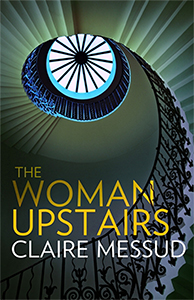A bee inside a violin inside a pear: The Woman Upstairs by Claire Messud
Claire Messud’s previous book, The Emperor’s Children (2006), was that rare beast, a best-seller which won multiple awards. It is a ‘state of the nation’ novel that addresses an ambitious range of questions with wit and style, through a complex narrative about the belated coming-of-age of a group of 30-ish friends in New York, around 2001. A hard act to follow, one might think.
With The Woman Upstairs, her fifth book, Messud narrows her range, concentrating on a devastated woman recounting a critical event in her life. Nora is an elementary school teacher living in Cambridge, Massachusetts, who experiences a ‘Lucy Jordan moment’ when she realises at the age of 37 that her life, like that of the ballad’s heroine, looks small and any hope for change is not for her. She lives alone, and has recently lost her mother to a particularly cruel form of motor neurone disease. She once had ‘a love, and a love affair with a worldly life, and I left it’; she also once had ambitions to be an artist. But only vestiges of that self remain, in the miniature dioramas that she makes for a series entitled ‘A Room of One’s Own?’. She feels she has done well as a dutiful daughter, and not too badly on the career front, but she fears she has not left enough time to answer the ‘two big exam questions’ that really matter, ‘the question of art, and the question of love’.
Both questions will be posed by the Shahid family, newly arrived from Paris. Reza, the beautiful eight year old boy who comes into her class, ‘a child from a fairy tale’, is the son of Sirena, an Italian installation artist, and Skandar, a French-educated Lebanese historian of ideas. Nora feels that in their presence the world opens up to her – there is hope, and a feeling of possibility. Reza calls forth her protective maternal love, Sirena is a siren call to her ambitious desires, and Skandar, whose name is an Arabic version of Alexander, enchants her with his talk of the wider world of politics and history where he seems like a modern Alexander the Great – and both adults inspire sexual desires that are intensified by Nora’s loneliness. She agrees to share a studio with Sirena, whom she helps with an ambitious installation based on Alice in Wonderland, and works with new delight on her own art. She becomes obsessed with Sirena, whose friendly embrace can send her into an ecstasy and whose failure to telephone can pitch her into despair. In this strange realm of obsession, Nora wants to be Sirena as much as she wants to possess her. Sirena is, after all, the ‘ideal woman artist’ that Nora has so far failed to be.
It’s bound to end badly, of course, as Nora’s narrative hints from the very beginning. As readers, we are given good reason to anticipate this from the indirect observations allowed us. In a rare reality check, Nora’s sensible friend Didi says: ‘So you’re in love with Sirena and you want to fuck her husband and steal her child. Have I got it right?’ Nora hotly denies this, yet there is a caricatured kind of truth about it. Even so, the betrayal she eventually suffers at Sirena’s hands is extreme. In retrospect, Nora realises that all three Shahids are like the black monk in Chekhov’s story of that name. Each of them has reawakened her to a belief in herself and the possibilities of life: ‘Each one, in my impassioned interior conversation, granted me some aspect of my most dearly held, most fiercely hidden, heart’s desires: life, art, motherhood, love and the great seductive promise that I wasn’t nothing.’ But the black monk is a figment of the imagination of Chekhov’s lonely and embittered protagonist. Are we to understand the Shahids similarly?
Messud takes on the difficult task of creating Nora as an unreliable – and also often unlikeable – narrator. Unlike the narrator of her earlier novella, The Hunters (2001), who is quite clearly delusional, Nora is only desperately needy and possessed of – and by – a perfervid imagination. She is pathetic but also brave. She is provincial and limited, but also open to new experiences, and vulnerably so. As narrator, she deflects our pity at the same time as she demands our belief in her, and she is defensive, introducing herself with an angry tirade: ‘How angry am I? You don’t want to know. Nobody wants to know about that.’ Messud has spoken of her fascination with ‘ranting’ narrators in fiction, and how rare it is for such unlikeable figures to be female, remarking that ‘nothing is more unseemly in society than an angry woman’. Nora is her experiment in creating a female protagonist who is driven by an anger so fierce that she could kill – or else immolate herself in its fire. Yet the self-consciously angry passages that frame the novel are not entirely convincing, given the ‘woman upstairs’ persona that Nora inhabits throughout the tale that she recounts.
Nora’s narrative is scattered with literary references to her situation. There is not only the monk who haunts Chekhov’s poor scholar but other stories of sequestered souls in torment – she alludes to the protagonist of Ralph Ellison’s Invisible Man (1952) in his basement, and to Dostoevsky’s Notes From Underground (1864), only to deny their relevance to her own ‘upstairs’ and apparently eminently sane self. Women like herself are ‘always upstairs. We’re not the madwomen in the attic – they get lots of play, one way or another … In our lives of quiet desperation the woman upstairs is who we are … and not a soul registers that we are furious. We’re completely invisible.’ The reference to Sandra Gilbert and Susan Gubar’s feminist study of women’s novels, The Madwoman in the Attic: The Woman Writer and the Nineteenth-Century Literary Imagination (1979), the title of which alludes to the character of Bertha Mason in Jane Eyre (1847), slides with apparent inevitability to Thoreau’s famous line about ‘lives of quiet desperation’. And of course a heroine named Nora does not have to draw attention to the parallel with Ibsen’s heroine, escaping more than a century earlier from a different doll’s house, a different kind of confinement in ordinariness.
‘I want to make my nothingness count,’ says Nora. This is, essentially, the challenge that Messud has set herself in writing Nora’s story: how to make a character who is ordinary and somewhat pathetic into a narrator whose voice demands and retains attention. This is achieved in part through the affective power of the story, and in part through descriptions of both Nora’s and Sirena’s art works and the processes of their making.
Nora practises the art of the diorama, constructing painted and furnished miniature rooms in which her chosen women artists are to be depicted: reclusive Emily Dickinson in her Amherst bedroom; the painter Alice Neel as a young woman imprisoned in an asylum ward; Virginia Woolf filling her pockets with stones and writing her suicide note; and finally Edie Sedgwick’s room in Warhol’s Factory, wallpapered with images of her waif-like beauty – Sedgwick representing the opposite of the artist: a woman who ‘existed only in the public gaze’. Nora only ever completes the first of this series, the Emily Dickinson. This suggests that she will always remain a hidden artist – not succumbing to madness, certainly, but also without the will to drive her project to completion. Her choice of art form is also significant: the ‘dollhouse labour’ required to make her own ‘Lilliputian world’ recalls her work as a teacher with young children at the same time as it echoes her habitual self-effacement. ‘Why so small?’ asks Skandar of her dioramas; ‘is it because they feel they’re not allowed to be bigger?’ But they do allow Nora, as their maker, the illusion of complete control, creating a god’s eye view of a microcosm. In the conversations with Skandar that awaken her to the wider world, Nora repeatedly has the experience of feeling ‘as if the lid has come off the world, as if the world were a dollhouse, and you can glimpse what it would be like to see it whole, from above.’ As an artist, too, she likes to see from above a whole dollhouse world of her own making.
These miniature rooms suggest the interior space and time of her subjectivity is diminished and bounded. Indeed, as Susan Stewart argues in On Longing: Narratives of the Miniature: The Gigantic, the Souvenir, the Collection (1993) miniatures belong to the genre of tableau rather than narrative. They tend ‘toward silence and spatial boundaries rather than toward expository closure.’ While Nora’s narrative takes exactly that expository direction, her art work tends toward silence and stasis. In some respects, it merely repeats the miniature diorama format for which she first received praise at school, when the students were set the quite surrealist exercise of representing ‘a bee inside a violin inside a pear’ .
Nora’s works also evoke the theatrical origins of the diorama, where an illuminated painted scene, often with model figures, is viewed through an opening; where a whole tableau can be glimpsed as if from a great distance. And it is exactly this impression of being watched from outside or above by an unseen observer that assails Nora when she is working at night in the studio: ‘I’d look up from my table and realize that I was alone in a tiny pool of light in a great dark room, as if I were myself the figure in someone else’s diorama, manipulated in my own stage set by a giant I could not see’ – a chilling intimation of the novel’s resolution.
Ekphrasis, the representation of a visual object in a literary text, functions in The Woman Upstairs as a model or icon of each woman’s character. Sirena’s larger-than-life-sized Wonderland scenes, ironised by her recycling of household junk for their materials, require human actors to enter into them and make them their own – as Nora does. In contrast, Nora’s exquisite dioramas, where each tiny object is hand-made, can only be observed from a distance, and they contain their maker’s most secret desires, encrypted.
Nora tells Sirena how she turned to making these ‘rooms the size of shoe boxes’ when her mother was dying and she ‘stopped being able to make any big gestures at all’. She cannot, however, bring herself to explain how she also stopped trying to show her work, but kept these pieces close to her, as if to keep them and her mother alive. ‘These are the fragments I have shored against my ruin’ she says, paraphrasing T.S. Eliot’s line from The Waste Land (1922), and her narrative, like that poem, has an undercurrent of unresolved grief and longing.
Nora remarks in passing that when the Shahids entered her life, ‘My mother was only two years dead, that fall. It felt like an immense distance then, but now, in time’s accordion folds, the two events … seem almost contiguous.’ Despite her excitement and pleasure, there is a sense in which Nora remains trapped in grief. The ‘longing’ that she identifies as her overriding feeling speaks to this interpretation: it is a desire that will never be satisfied, so that ‘it carries its quality of reaching, but not attaining, of yearning, of a physical pull that is intense and yet melancholy, always already a little sorrowful, self-knowing, in some wise passionate and in some measure resigned.’ This passivity is finally overcome when the revelation of betrayal makes her ‘angry enough, finally, God willing, with my mother’s anger also on my shoulders, a great boil of rage like the sun’s fire in me – before I die to fucking well live.’ It is as if part of Nora has died with her mother, the part that was always recognised and loved: ‘Once your mother dies, nobody loves you best of all,’ she reflects. At the core of the novel, then, is the exploration of her subjectivity, signalled by the epigraph taken from Machiavelli’s The Prince (1532): ‘Everyone sees what you appear to be, few experience what you really are.’
Even if her expressions of rage are less convincing than her expressions of need and desire and her underlying grief, the function of Nora’s anger is empowerment. It is a familiar feminist theme: when a woman is driven to anger instead of sadness, she is invigorated and emboldened; it enables her to assert herself, ‘to fucking well live’. For Nora, it also drives her to make a different kind of art: the narrative that she creates as she looks back some years later on the Shahid experience. Unlike the frozen moments and the deathly associations of her shrine-like dioramas, it is a totally new aesthetic for her. It aims at Susan Stewart’s ‘expository closure’: ‘But if I can just explain, all will be elucidated; and maybe that elucidation alone will prove my greatness, however small. To tell what I know, and how it feels, if I can. You might see yourself, if I do.’ The ‘you’ here can be the reader, who is constantly addressed directly in the framing opening and closing chapters; but it is surely also Nora’s other self, so secret as to be unreachable by her everyday self. And her ‘greatness, however small’ is precisely the point.
‘The question now is how to work it, how to use that invisibility, to make it burn,’ says Nora. If ‘fantasy determines reality,’ as she believes, then invisibility is a better fantasy than escape by flying away, because being invisible ‘makes things more real’: ‘You walk into a room where you are not, and you hear what people say, unguardedly; you watch how they move when they aren’t with you. You see them without their masks – or in their various masks, because suddenly you can see them anywhere. It may be painful to learn what happens when you’re behind the arras; but then, please God, you know.’ Nora is claiming a new kind of power, the power of the fiction writer. And her creator, Claire Messud, has demonstrated her ability to exercise that power in spades.
References
Sandra Gilbert and Susan Gubar, The Madwoman in the Attic: The Woman Writer and the Nineteenth-Century Literary Imagination (Yale University Press, 1979).
Susan Stewart, On Longing: Narratives of the Miniature, the Gigantic, the Souvenir, the Collection (Duke University Press 1993).
‘The Woman Upstairs: A saga of anger and thwarted ambition,’ NPR Books (9 May 2013).






